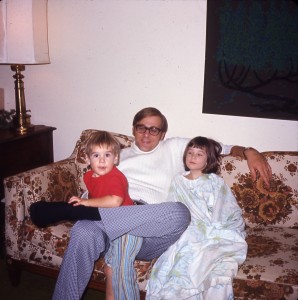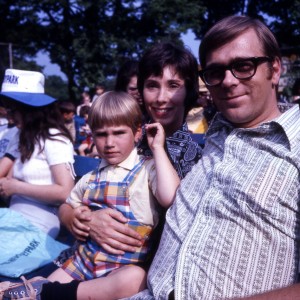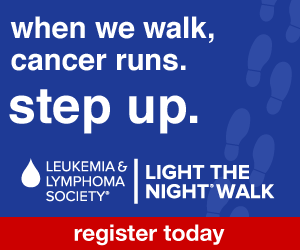Three weeks back I gave an ending talk at the ILEAD U project. It was about overcoming fear and resistance, and the importance of building a team that will encourage you to move on. A few folks told me how that message was important outside of the context of librarianship and the project. Upon request, I have written down my thoughts for a more general audience. If you would like to read more about my journey with cancer, please consider my book, The Boring Patient.
The Parable of the 42 Steps
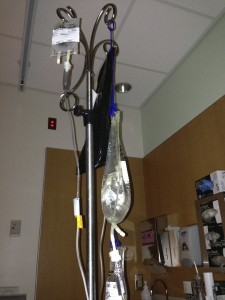 The stories we tell help us make sense of events in our lives, as well as helping others learn from our experiences. Many have asked me what my journey with cancer taught me. They comment on hard it must have been, or how scared I must have been, or how reflective I must have been. My reaction is normally to minimize the difficulty of my treatment, preferring humor and looking forward rather than focusing on a dark chapter in my life. However, recent events have shown me that in the darkness I can find something to share for those who are struggling in their own lives: be it in work, in a relationship, or simply to continue forward in the face of a creeping push to simply stop, lie down, and give up. For me, one of the key lessons I learned happened in 42 steps.
The stories we tell help us make sense of events in our lives, as well as helping others learn from our experiences. Many have asked me what my journey with cancer taught me. They comment on hard it must have been, or how scared I must have been, or how reflective I must have been. My reaction is normally to minimize the difficulty of my treatment, preferring humor and looking forward rather than focusing on a dark chapter in my life. However, recent events have shown me that in the darkness I can find something to share for those who are struggling in their own lives: be it in work, in a relationship, or simply to continue forward in the face of a creeping push to simply stop, lie down, and give up. For me, one of the key lessons I learned happened in 42 steps.
What many people do not talk about when they recount life in chemo, is how small your world becomes. In the years before cancer I traveled to Austria, Rome, Amsterdam, Australia and China. I spent a fair amount of my time in the air going from talk to talk as a professor. When my illness first appeared as a set of seizures, and then as a diagnosis with Hodgkin’s Lymphoma, my world shrank. What had been moving from home to work to the world became moving between work, home, and the hospital.
After six months of treatment, work, home and hospital came the devastating news that the cancer was still there. Still there and growing again. Still there and killing me. Still there and requiring another, more extreme treatment. As one doctor put it: where the first round of chemo was hitting me with a hammer, I needed one that would hit me with a sledgehammer.
My life shrank again from the work to home to the hospital. Eventually as the toxins took their toll, my world became simply the hospital for treatment, and home to recover. The end of this process was a bone marrow transplant that meant my world shrank from home and the hospital to just a hospital ward 42 steps long; locked away from the world, my friends, and my children.
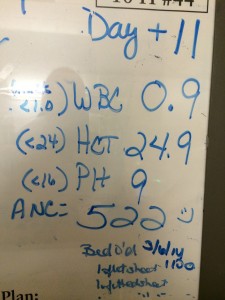 The process began by checking into the hospital and being hooked up to a rolling metal pole that held a pump that shot a steady stream of chemo into my blood stream. That was day -9. On day -1 nurses fed me a steady stream of ice chips to slow the circulation in my mouth. The last toxin, Melphalan, would tear through my digestive system from entrance to exit. Ice hips slowed circulation in my mouth and would minimize open sores in my cheeks and gums. On day 0, my stem cells were injected, and the transplant process began
The process began by checking into the hospital and being hooked up to a rolling metal pole that held a pump that shot a steady stream of chemo into my blood stream. That was day -9. On day -1 nurses fed me a steady stream of ice chips to slow the circulation in my mouth. The last toxin, Melphalan, would tear through my digestive system from entrance to exit. Ice hips slowed circulation in my mouth and would minimize open sores in my cheeks and gums. On day 0, my stem cells were injected, and the transplant process began
As the days rolled on my blood cells died with no marrow to replace them. My body’s vital system of feeding and repairing itself began to falter and fail. I was tired, every swallow felt like shards of glass and barbed wire being dragged down my throat and into my chest. At night, nerve damage lead to uncontrollable twitching, robbing me of sleep.
The nurses told me that one key to a successful transplant was to walk. So every day I would walk. Every day consisted of 42 steps up the ward, and 42 steps down, up and down, over and over. As my blood counts dropped, I walked. The nurses would feed me painkillers, and anti-nausea drugs and tell me to walk. 42 steps up, 42 steps down.
As day 0 become day 3 and then day 5, it became harder and harder to get out of bed, but my wife would come into my room and tell me to walk: 42 steps up, 42 steps down. As my muscles cried out for oxygen from a crashing red cell count, and the remaining toxins tore up my gut, my mother would visit, and tell me to walk. 42 steps up, 42 steps back, 42 steps up, 42 steps down. Ativan for the twitching, 42 steps. Oxycodone for the pain, 42 steps.
 My white blood count went to 0. My children couldn’t visit because a stray infection picked up from school could kill me and I couldn’t bear the thought of them feeling responsible for my death. I would try to sleep as every hour the nurses checked my temperature, pulse, and blood pressure. So at 1 in the morning I was awake. 42 steps up, 42 steps down. 42 steps up, 42 steps down. On day 9 I couldn’t get out of bed. I hurt, and was tired, and even the drugs couldn’t prevent me from wanting to give up. To stop the walking, and eating, and caring. All I could do was lie in bed and feel sorry for myself, and just want it to end…and the nurses and the doctors checked me, and tried to reassure me it would get better. And my wife? She made me walk “just 42 steps.”
My white blood count went to 0. My children couldn’t visit because a stray infection picked up from school could kill me and I couldn’t bear the thought of them feeling responsible for my death. I would try to sleep as every hour the nurses checked my temperature, pulse, and blood pressure. So at 1 in the morning I was awake. 42 steps up, 42 steps down. 42 steps up, 42 steps down. On day 9 I couldn’t get out of bed. I hurt, and was tired, and even the drugs couldn’t prevent me from wanting to give up. To stop the walking, and eating, and caring. All I could do was lie in bed and feel sorry for myself, and just want it to end…and the nurses and the doctors checked me, and tried to reassure me it would get better. And my wife? She made me walk “just 42 steps.”
Day 10 and 11 were better. My counts got better. My body began to repair itself. So I walked and I walked, and by day 14 they told me I could go home. I had walked 33 miles on that ward – 42 steps at a time.
I could end the story there: I go home, I’ve made it through. But that is not the moral of this story. You see, the real effort – the real work – was not in the transplant, but in the struggle to cope with a world that had to grow again
Leaving the hospital was not easy. People would say how relieved I must have been to go home. But to me it was one of the most frightening things I had ever done. I was leaving behind the doctors. I was leaving behind the nurses, and the drugs, and the HEPA filter, and the safety of an isolation ward. I was going home in the middle of cold and flu season, and a stray virus could kill me. Forcing my world to expand from a hospital ward to home and then to work was as much effort as getting out of bed on day 9.
Expanding my world was effort I never imagined would be so great. It was having a panic attack in the lobby of a library; my chest feeling like it was going to burst. All I wanted to do was run home or collapse into a fetal position on the floor. I called my wife: “go outside” she said ” go outside and just walk. Just start with 42 steps.
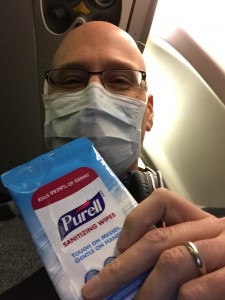 Expanding my world was getting on my first plane in over a year. I had to get through security – 42 steps through the line. I had to get to my gate – 42 steps to the gate. I had to get on the plane with a surgical mask and worried glances…42 steps down the jetway; 42 steps down the aisle.
Expanding my world was getting on my first plane in over a year. I had to get through security – 42 steps through the line. I had to get to my gate – 42 steps to the gate. I had to get on the plane with a surgical mask and worried glances…42 steps down the jetway; 42 steps down the aisle.
And there it is – there is the point of the parable. We all have times when our world shrinks by choice or apathy. Maybe it’s going back to school where your world has collapsed into courses and textbooks. Maybe it’s a job that has become routine. It is natural to look at a bigger world with fear and anticipations of failure, it is natural to want to stay in bed: to say no more; to give up. That’s when you need to force yourself to take those steps. That’s when we all need a team to push us and say “just 42 steps.”
We all face challenges, we all have times of depression, or failure, or where we simply want to stop. These challenges are not minor or unimportant – you have every right and every reason to simply stay in bed, to simply stay where you are and give up. But you can move forward, even if just a little bit, even if it is only 42 steps.

